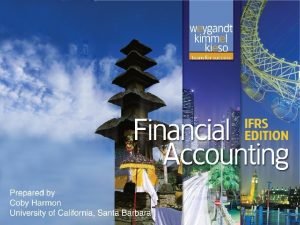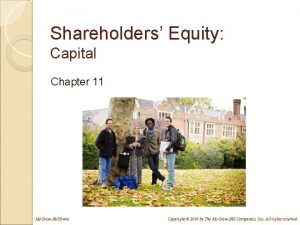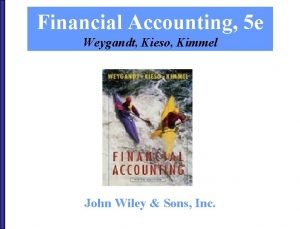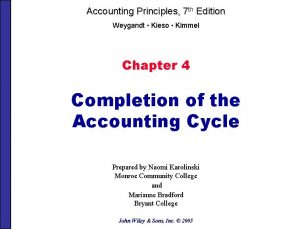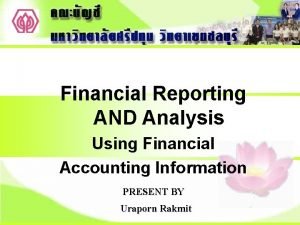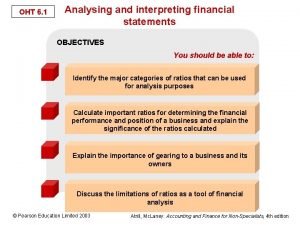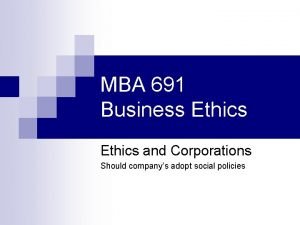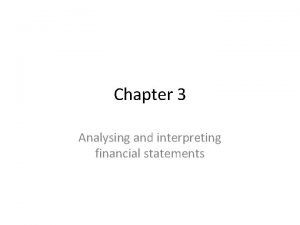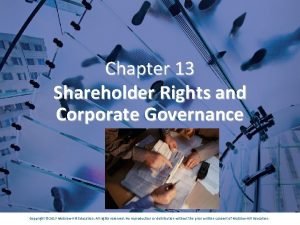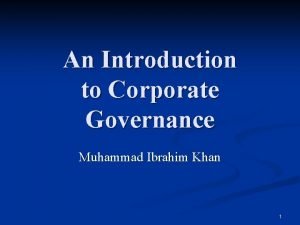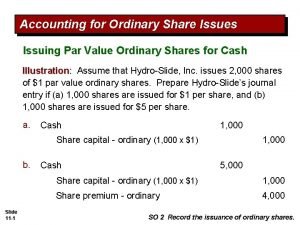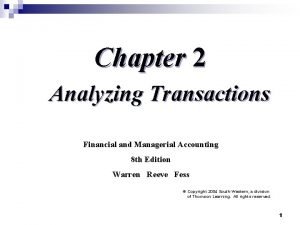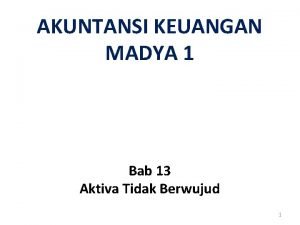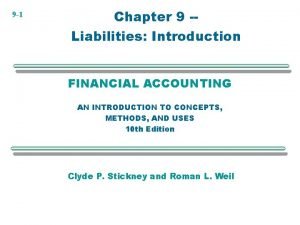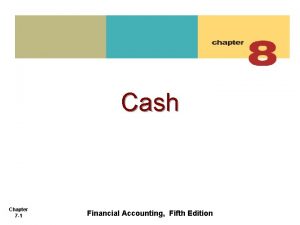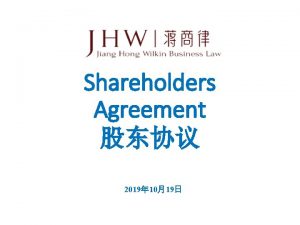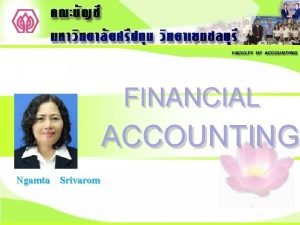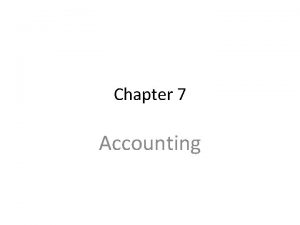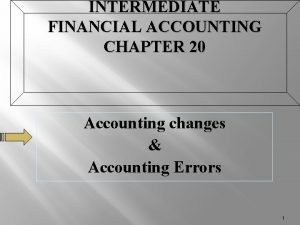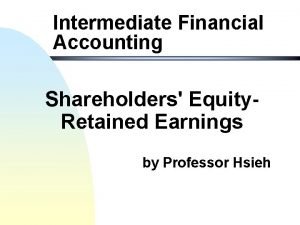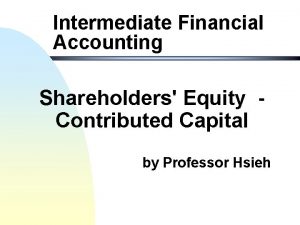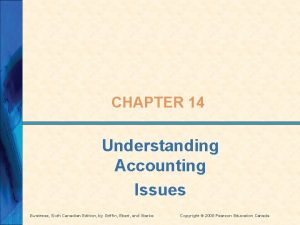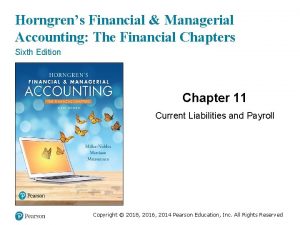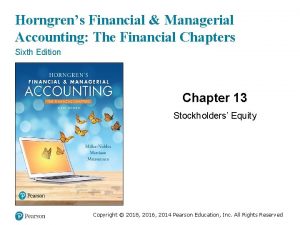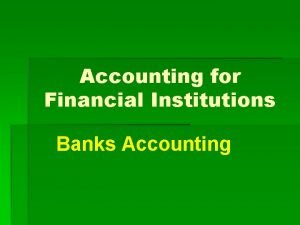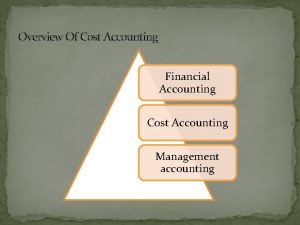Financial Accounting Sixth Canadian Edition Chapter 9 Shareholders











































- Slides: 43

Financial Accounting Sixth Canadian Edition Chapter 9 Shareholders’ Equity Copyright © 2018 Pearson Canada Inc.

Learning Objective One Explain the main features of a corporation Copyright © 2018 Pearson Canada Inc.

Characteristics of a Corporation Separate legal entity Continuous life and transferability of ownership Limited liability Separation of ownership and management Corporate taxation Government regulation Copyright © 2018 Pearson Canada Inc.

Corporate Characteristics ADVANTAGES DISADVANTAGES • Can raise more capital than a • Separation of ownership and proprietorship or partnership can management • Continuous life • Corporate taxation • Transferability of ownership • Government regulation • Limited liability Copyright © 2018 Pearson Canada Inc.

Shareholders Board of Directors President (Chief Operating Officer) Vice-Presidents Controller Chief Financial Officer Secretary Treasurer Copyright © 2018 Pearson Canada Inc.

Shareholder Rights Sell Shares Vote Dividends Residual Interest Copyright © 2018 Pearson Canada Inc.

Shareholders’ Equity Owners’ equity in a corporation has four main components: Share Capital (capital Share or share capital) Accumulated Other Comprehensive Income Contributed Surplus Retained earnings Copyright © 2018 Pearson Canada Inc.

Capital Shares Corporate ownership is evidenced by a share certificate, which may be for any number of shares. The total number of shares authorized is limited by the articles of incorporation. Copyright © 2018 Pearson Canada Inc.

Classes of Share COMMON • Basic form of capital • Has four rights • Shareholders benefit most if corporation succeeds – Take more risk PREFERRED • Has advantages over common – Receive dividends first – Receive assets first in liquidation • Shareholders earn a fixed dividend • Very few corporations issue Copyright © 2018 Pearson Canada Inc.

Comparison of Issuing Shares and Debt Common Shares Obligation to repay No principal Preferred Shares No Long-term debt Yes Dividends/interest Dividends are not Dividends are tax-deductible not taxdeductible Interest expense is tax-deductible Obligation to pay dividends/interest Only after declaration At fixed rates and date Only after declaration Copyright © 2018 Pearson Canada Inc.

Par Value • Arbitrary amount assigned to a share • Federally and most provincially incorporated companies have shares issued without par value Copyright © 2018 Pearson Canada Inc.

Learning Objective Two Account for the issuance of shares Copyright © 2018 Pearson Canada Inc.

Issuing Shares For Cash JOURNAL Date Accounts and explanation Cash Common Share Capital Debit Credit 5, 000, 000 Issued Share at $50 per share Copyright © 2018 Pearson Canada Inc.

Shares Issued for Non-Cash Assets • Asset received is recorded at current market value JOURNAL Date Accounts and explanation Equipment Building Common Share capital Debit Credit 4, 000 120, 000 124, 000 Issued shares in exchange for equipment and building Copyright © 2018 Pearson Canada Inc.

Preferred Shares Accounting for preferred shares follows the pattern illustrated for common shares. Shareholders’ equity on the balance sheet lists preferred shares, common shares, contributed surplus, accumulated other comprehensive income, and retained earnings – in that order. Copyright © 2018 Pearson Canada Inc.

Learning Objective Three Explain why a company repurchases shares Copyright © 2018 Pearson Canada Inc.

Shares Reacquired By the Company • Reasons: 1. The company needs the repurchased shares to fulfill future share issuance commitments. 2. The purchase may help support the share’s current market price. 3. Management wants to avoid a takeover by an outside party. Copyright © 2018 Pearson Canada Inc.

Learning Objective Four Account for retained earnings, dividends and stock splits Copyright © 2018 Pearson Canada Inc.

Retained Earnings Copyright © 2018 Pearson Canada Inc.

Retained Earnings Balance Copyright © 2018 Pearson Canada Inc.

Cash Dividends • Company must have both: – Enough Retained earnings to declare the dividend – Enough Cash to pay the dividend • Board of directors has authority to declare a dividend – Company not obligated to pay dividend until declared Copyright © 2018 Pearson Canada Inc.

Dividend Dates (1 of 3) 1. Declaration date JOURNAL Date Accounts and explanation Debit Credit Retained Earnings Dividends Payable Copyright © 2018 Pearson Canada Inc.

Dividend Dates (2 of 3) 2. Date of record No entry Copyright © 2018 Pearson Canada Inc.

Dividend Dates (3 of 3) 3. Payment date JOURNAL Date Accounts and explanation Debit Credit Dividends Payable Cash Copyright © 2018 Pearson Canada Inc.

Stock Dividends • Proportional distribution of stock to shareholders • Increase Share account and decrease Retained Earnings – Total equity is unchanged • Reasons stock dividends are distributed – Continue dividends, but conserve cash – Reduce market price of shares Copyright © 2018 Pearson Canada Inc.

Stock Dividend Dates 1. Declaration date JOURNAL Date Accounts and explanation Debit Credit Retained Earnings Stock Dividends Distributable 2. Date of record No entry 3. Payment date JOURNAL Date Accounts and explanation Stock Dividends Distributable Common Shares Copyright © 2018 Pearson Canada Inc.

Dividends on Preferred Share • Paid dividends before common Shareholders • Stated as a percent of par value or a dollar amount per share • May be cumulative – Passed dividends are owed to preferred shareholders § In arrears Copyright © 2018 Pearson Canada Inc.

Dividends on Preferred Shares The preferred shares of Pinecraft are cumulative. Suppose the company passed the 2016 preferred dividend of $150, 000. In 2017, the company declares a $500, 000 dividend. Retained Earnings 500, 000 Dividends Payable, Preferred 300, 000* Dividends Payable, Preferred ($500, 000 – $300, 000) 200, 000 To declare a cash dividend *($150, 000 × 2 years) Copyright © 2018 Pearson Canada Inc.

Stock Splits • Increase in shares with a proportionate reduction in par value • Decreases market price of shares • No accounts affected Copyright © 2018 Pearson Canada Inc.

Effect on Total Transaction Issuance of shares Assets = Liabilities + Shareholders’ Equity Increase No effect Increase Repurchase of shares Decrease No effect Decrease Declaration of cash dividend No effect Increase Decrease Payment of cash dividend Decrease No effect No effect Stock dividend Stock split Copyright © 2018 Pearson Canada Inc.

Learning Objective Five Distinguish between fair value and book value per share Copyright © 2018 Pearson Canada Inc.

Fair Value The fair value (or market price) of a share of a company’s stock is the price that a willing buyer would pay a willing seller to acquire the share Copyright © 2018 Pearson Canada Inc.

Book Value (1 of 2) Book value per preferred share = (Redemption value + Dividends in arrears) ÷ Number of preferred shares outstanding Book value per common share = (Total shareholders’ equity – Preferred equity) ÷ Number of common shares outstanding Copyright © 2018 Pearson Canada Inc.

Book Value (2 of 2) Assume that a company’s balance sheet reports the following: Shareholders’ Equity Preferred shares, $6. 00, 400 shares issued, redemption value $130 per share $ 40, 000 Common shares, 5, 000 shares issued 131, 000 Retained earnings 70, 000 Total shareholders’ equity $241, 000 Suppose that four years’ (including the current year) cumulative preferred dividends are in arrears. Dividends are $6 per share Copyright © 2018 Pearson Canada Inc.

Book Value Per Common Share Preferred equity: Redemption value (400 shares × 130) $ 52, 000 Cumulative dividends (400 × $6. 00 × 4 years) 9, 600 Preferred equity $ 61, 600 Common equity: Total shareholders’ equity $241, 000 Less preferred equity – 61, 600 Common equity $179, 400 Book value per share: $179, 400 ÷ 5, 000 shares $ 35. 88 Copyright © 2018 Pearson Canada Inc.

Learning Objective Six Evaluate a company’s return on assets and return on equity Copyright © 2018 Pearson Canada Inc.

Return on Assets Return on equity = Copyright © 2018 Pearson Canada Inc.

Return on Equity Return on equity = Copyright © 2018 Pearson Canada Inc.

Learning Objective Seven Report equity transactions and events in the financial statements Copyright © 2018 Pearson Canada Inc.

Statement of Changes in Shareholders’ Equity Canadian Tire Corporation Consolidated Statement of Changes in Shareholders’ Equity (Adapted) For the Year Ended January 3, 2015 (in millions) Balance as at December 28, 2013 Share Capital Contributed Surplus Accumulated Comprehensive Income Retained Earnings Total $ 712. 9 $ 2. 4 $ 47. 4 $ 4, 404. 6 $ 5, 167. 3 604. 0 (13. 1) 21. 5 Net income Other comprehensive income (loss) Issuance of Class A non-voting shares Repurchase of Class A non-voting shares Excess of repurchase price over average cost 34. 6 6. 9 (290. 6) 266. 3 (266. 3) 0. 0 Dividends (154. 1) Issuance of redeemable financial instruments (500. 0) Contributed surplus arising on sale of property Balance as at January 3, 2015 0. 5 $ 695. 5 $ 2. 9 0. 5 $ 82. 0 $ 4, 075. 1 $ 4, 855. 5 Copyright © 2018 Pearson Canada Inc.

Shareholders’ Equity on the Balance Sheet Copyright © 2018 Pearson Canada Inc.

Shareholders’ Equity on the Balance Sheet, Statement of Changes in Owners’ Equity, and Notes Required Equity Information: • Number of authorized, issued, and outstanding shares, and changes during the year; their par value, if any; dividend rights and preferences; and other restrictions and features • Contributed surplus • Accumulated other comprehensive income (IFRS only) • Retained earnings Copyright © 2018 Pearson Canada Inc.

End of Chapter Nine Copyright © 2018 Pearson Canada Inc.
 Shareholders equity and shareholders funds
Shareholders equity and shareholders funds Accounting principles second canadian edition
Accounting principles second canadian edition Accounting principles second canadian edition
Accounting principles second canadian edition Accounting principles second canadian edition
Accounting principles second canadian edition Accounting principles second canadian edition
Accounting principles second canadian edition The sixth sheik's sixth sheep's sick
The sixth sheik's sixth sheep's sick The sixth sick sheik's sixth sheep's sick lyrics
The sixth sick sheik's sixth sheep's sick lyrics Financial accounting ifrs 4th edition chapter 12
Financial accounting ifrs 4th edition chapter 12 Financial accounting chapter 1
Financial accounting chapter 1 Chapter 11 shareholders rights
Chapter 11 shareholders rights Kimmel accounting 5e
Kimmel accounting 5e Kimmel financial accounting 7the edition
Kimmel financial accounting 7the edition Using financial accounting information 10th edition
Using financial accounting information 10th edition Biochemistry sixth edition
Biochemistry sixth edition Computer architecture a quantitative approach sixth edition
Computer architecture a quantitative approach sixth edition Automotive technology principles diagnosis and service
Automotive technology principles diagnosis and service Automotive technology sixth edition
Automotive technology sixth edition Citation sample pdf
Citation sample pdf Computer architecture a quantitative approach 6th
Computer architecture a quantitative approach 6th Precalculus sixth edition
Precalculus sixth edition Principles of economics sixth edition
Principles of economics sixth edition Computer architecture a quantitative approach sixth edition
Computer architecture a quantitative approach sixth edition Marketing an introduction 6th canadian edition
Marketing an introduction 6th canadian edition Fundamentals of corporate finance 3rd canadian edition
Fundamentals of corporate finance 3rd canadian edition Fundamentals of corporate finance canadian edition
Fundamentals of corporate finance canadian edition Accounting responsibility
Accounting responsibility Salaam bank somaliland
Salaam bank somaliland Return on ordinary shareholders equity formula
Return on ordinary shareholders equity formula Stockholders vs shareholders
Stockholders vs shareholders Return on shareholders fund formula
Return on shareholders fund formula Shareholder vs stockholder
Shareholder vs stockholder Types of shareholders
Types of shareholders Return on ordinary shareholders equity formula
Return on ordinary shareholders equity formula Avocet shareholders forum
Avocet shareholders forum West wits mining top 20 shareholders
West wits mining top 20 shareholders Canadian institute of financial planners
Canadian institute of financial planners Accounting 1 7th edition chapter 7
Accounting 1 7th edition chapter 7 Using mis (10th edition) 10th edition
Using mis (10th edition) 10th edition Zulily case study
Zulily case study Managerial accounting chapter 2 solutions
Managerial accounting chapter 2 solutions Financial accounting chapter 13
Financial accounting chapter 13 Equity accounted investments
Equity accounted investments Financial accounting chapter 9
Financial accounting chapter 9 Financial accounting chapter 7
Financial accounting chapter 7







